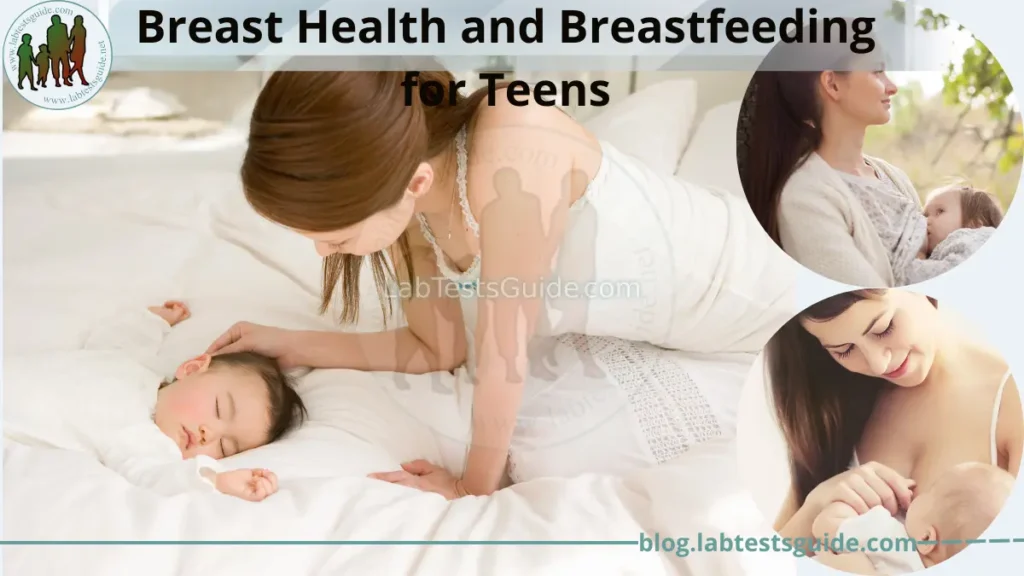Breast Health and Breastfeeding are important topics for teenage girls to understand and navigate. During the teenage years, girls experience various changes in their bodies, including breast development. It is crucial for teens to be aware of breast health and understand how to take care of their breasts. Additionally, for teenage mothers, breastfeeding is an essential aspect of infant care, promoting the health and well-being of both the mother and the baby.

Breast Development in Teens:
During the teenage years, girls go through a significant period of breast development as part of their physical maturation. Understanding the stages of breast development and the normal variations and concerns that may arise is important for teenagers to feel informed and comfortable with their changing bodies. Here are the key points related to breast development in teens:
Stages of Breast Development:
- Budding Stage: This is the initial stage of breast development when small, raised bumps called breast buds appear under the nipple. The breasts may feel tender or sore during this stage.
- Development of Glandular Tissue: As breast development progresses, glandular tissue increases, and the breasts continue to grow in size. The areolas may darken, and the nipples may become more prominent.
- Continued Growth and Maturity: The breasts continue to grow and reach their adult size and shape. The development process varies for each individual, and it can take several years for breasts to fully mature.
Normal Variations and Concerns:
- Asymmetry: It is common for one breast to develop faster or be slightly larger than the other during adolescence. Breast asymmetry usually resolves over time.
- Breast Pain or Tenderness: Breast discomfort or sensitivity is a normal part of breast development. Wearing a well-fitting bra and applying warm compresses can help alleviate discomfort.
- Uneven or Lumpy Texture: The breast tissue may feel lumpy or uneven, especially around the menstrual cycle. This is usually due to hormonal changes and does not necessarily indicate a health concern.
- Nipple Changes: The size, shape, and color of the nipples may change during breast development. Inverted or protruding nipples are also variations that can be considered normal.
It’s important to note that while breast development is a normal part of adolescence, any significant changes, persistent pain, unusual lumps, or other concerns should be brought to the attention of a healthcare provider for evaluation. Regular check-ups and open communication with a trusted healthcare professional can help address any questions or concerns related to breast development in teens.
Breast Health for Teens:
Maintaining breast health is crucial for teenagers as they go through the developmental changes in their breasts. Practicing self-examination, being aware of common breast issues, and seeking medical help when needed are important aspects of breast health for teens. Here are the key points related to breast health for teens:
Self-Examination and Awareness:
- Breast Self-Examination (BSE): Encourage teenagers to become familiar with their breasts through regular self-examination. BSE involves visually inspecting and gently feeling the breasts to detect any changes or abnormalities. It is best performed once a month, preferably a few days after the menstrual period ends when the breasts are least likely to be swollen or tender.
- Breast Awareness: Teach teens to be aware of the normal look and feel of their breasts. This includes being familiar with the size, shape, and texture of their breasts and noting any changes or new developments.
Common Breast Issues in Teens:
- Fibrocystic Changes: Many teenage girls experience fibrocystic changes, which can cause breasts to feel lumpy or tender. These changes are usually harmless, but if the symptoms become persistent or concerning, a healthcare provider should be consulted.
- Breast Infections: Infections such as mastitis or abscesses can occur in the breast tissue. Symptoms may include redness, swelling, warmth, pain, or fever. Medical attention is necessary to diagnose and treat these infections.
- Sports Injuries: Active teens participating in sports may experience breast injuries, such as bruising or trauma. If there is severe pain, swelling, or signs of a significant injury, medical evaluation should be sought.
Seeking Medical Help and Regular Check-ups:
- Communicate Openly: Encourage teens to openly discuss any concerns or changes they notice with a healthcare provider, such as a pediatrician, gynecologist, or primary care physician.
- Regular Check-ups: Schedule regular check-ups and examinations with a healthcare provider. This allows for professional assessment of breast health and early detection of any potential issues.
It’s important for teenagers to understand that most breast changes they experience during adolescence are normal and not indicative of breast cancer or other serious conditions. However, if there are any persistent or concerning symptoms, it is always recommended to seek medical advice for proper evaluation and guidance.
Breastfeeding and Teen Mothers:
Breastfeeding is a vital aspect of infant care, providing numerous benefits for both the baby and the mother. For teenage mothers, navigating the challenges and seeking appropriate support is essential for successful breastfeeding. Here are the key points related to breastfeeding and teen mothers:
Benefits of Breastfeeding for Babies and Mothers:
- Optimal Nutrition: Breast milk provides all the necessary nutrients and antibodies for a baby’s healthy growth and development.
- Immune System Support: Breastfed babies have a lower risk of infections, allergies, and certain chronic diseases.
- Bonding and Emotional Connection: Breastfeeding promotes a close bond between the mother and baby, providing comfort and emotional nourishment.
- Health Benefits for Mothers: Breastfeeding helps mothers recover from childbirth, reduces the risk of postpartum bleeding, and lowers the risk of breast and ovarian cancers.
Challenges and Support for Teen Mothers:
- Lack of Knowledge and Support: Teen mothers may face challenges due to limited information about breastfeeding and lack of support from family or peers. Education and counseling can help address these concerns.
- Physical and Emotional Demands: Breastfeeding requires time, patience, and dedication, which can be challenging for young mothers who may also be balancing school, work, or other responsibilities.
- Stigma and Social Pressure: Teen mothers may face societal stigma or pressure related to breastfeeding in public or concerns about body image. Encouraging a supportive and non-judgmental environment is important.
- Engaging Supportive Networks: Teen mothers can benefit from joining support groups, seeking guidance from lactation consultants, or connecting with other breastfeeding mothers to share experiences and advice.
Resources for Teen Mothers to Support Breastfeeding:
- Prenatal Education: Attending prenatal classes that cover breastfeeding topics can provide valuable information and build confidence.
- Lactation Consultants: Consulting with a certified lactation consultant can offer personalized guidance and assistance with any breastfeeding challenges.
- Peer Support Groups: Joining local or online support groups specifically for teenage mothers or breastfeeding mothers can provide a network of understanding and encouragement.
- Community Resources: Local health departments, women’s clinics, or breastfeeding organizations often offer resources and services tailored to the needs of teen mothers.
It’s important for teen mothers to know that breastfeeding is a personal choice, and they should be supported in making decisions that are best for themselves and their babies. Open communication, access to resources, and non-judgmental support can help teenage mothers navigate the breastfeeding journey successfully.
Conclusion:
Breast health and breastfeeding are important topics for teenagers, whether they are going through breast development or are teen mothers themselves. Understanding breast development stages, practicing self-examination, and being aware of common breast issues contribute to maintaining good breast health. For teenage mothers, breastfeeding provides numerous benefits for both the baby and the mother, but it can also come with challenges. Seeking support, educating oneself, and engaging with resources tailored to teenage mothers can help overcome these challenges and promote successful breastfeeding.
By prioritizing breast health and breastfeeding, teenagers can take control of their own well-being and make informed decisions. Regular check-ups, open communication with healthcare providers, and access to support networks are vital in navigating these aspects of adolescent and maternal health.
Encouraging an environment of understanding, acceptance, and support for teenagers’ choices regarding breast health and breastfeeding is essential. With the right knowledge and resources, teenagers can embark on a journey of healthy breast development or successful breastfeeding, promoting their own well-being and that of their babies.






